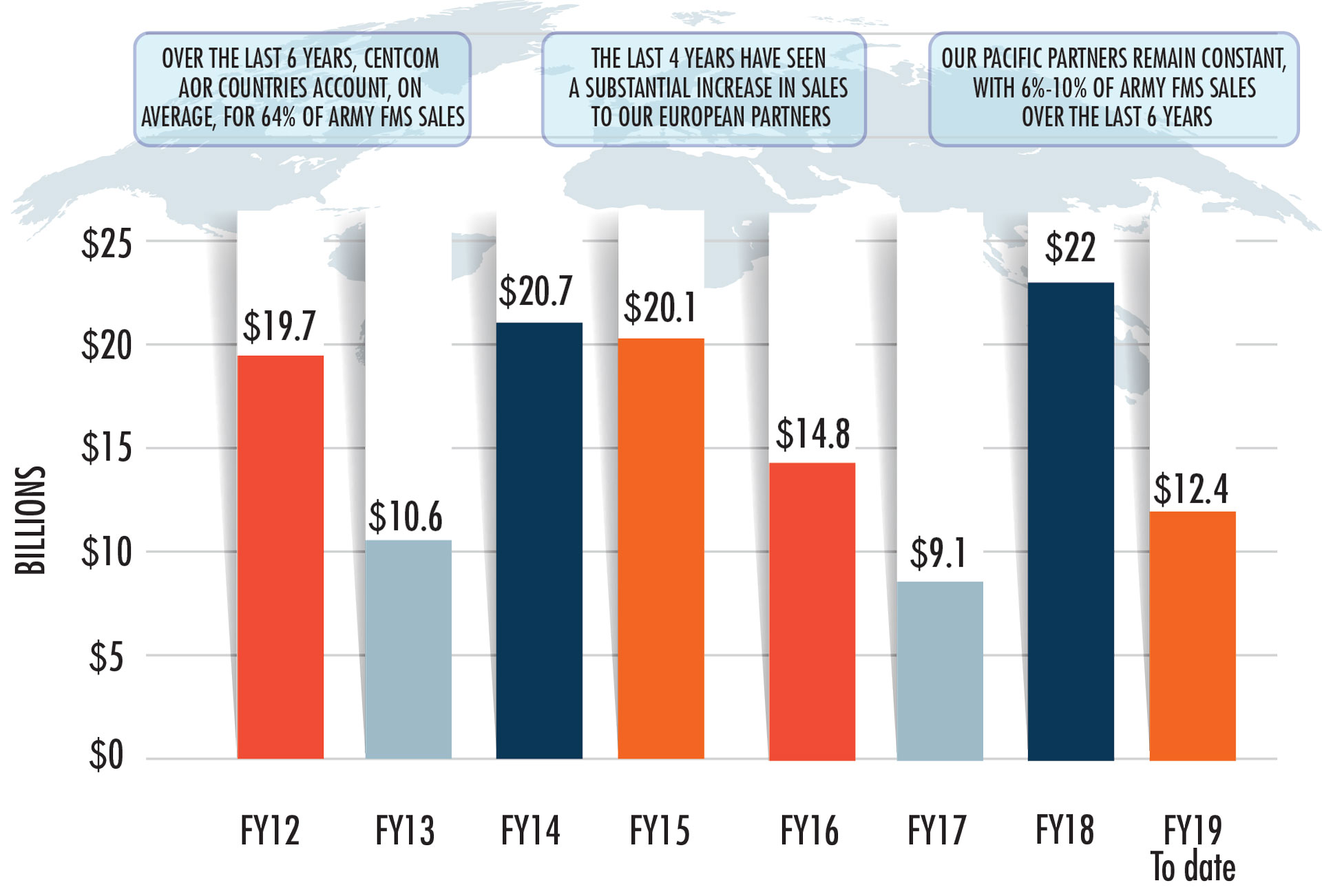
USASAC’s total package approach keeps FMS customers up and running.
by Adriane Elliot
There’s no doubt that foreign military sales (FMS) are a critical component of U.S. foreign policy. From bolstering our allies’ counterterrorism capabilities and regional stability to ensuring their interoperability and competency in helping the U.S. shoulder the burden of coalition operations, FMS will continue to play a role in our military’s ability to fight and win the multidomain battle.
One of our nation’s staunchest allies, Poland, completed an FMS package in February 2019 that was valued at $411 million. It includes 20 M142 High Mobility Artillery Rocket Systems. This purchase, combined with last year’s $4.6 billion FMS purchase of the Patriot Advanced Capability-3, is a significant boon to Poland’s widely touted military modernization plan, and to NATO capabilities.
With a volatile Russia on its eastern flank, Poland has aggressively stepped up its efforts to obtain more advanced weapons and to expand its defensive capabilities. The Patriot is one of the world’s most powerful air defense missile systems, and its purchase is Poland’s largest military procurement ever.
“Allies and partners buy from the United States because we sell the world’s most advanced defense systems,” said Lt. Gen. Charles W. Hooper, director of the Defense Security Cooperation Agency, which administers the FMS program for DOD. “Through the uniquely American approach to security cooperation, we also ensure our allies and partners have all the necessary training, education and institutional capacity to effectively employ and sustain the equipment we provide.”
The U.S. Army Security Assistance Command (USASAC) at Redstone Arsenal, Alabama, manages approximately 6,000 FMS cases valued at greater than $200 billion. The command interfaces with 119 security cooperation offices worldwide and provides security assistance and FMS to more than 150 nations and international partners.
When FMS customers enter into an FMS case with the United States, they are purchasing a portfolio of services that includes training, spare parts, technical manuals and the full backing of the U.S. government. This is known as the “total package approach.”
Without this sustainment support, “components will eventually break down. If an FMS customer purchases a tank but can’t acquire spare parts and other maintenance necessities, that tank is nothing more than a huge paperweight in their motor pool,” said Cindy Decker, chief of the Services and Products Division within USASAC’s G-4 Acquisition Support Branch.

USASAC manages roughly 6,000 FMS cases valued at more than $200 billion, providing U.S. partners and allies with equipment and training. USASAC’s total package approach includes not just the weapon system but also the parts, maintenance and logistics support to keep the system operational. (Image by USASAC and the U.S. Army Acquisition Support Center)
FINDING THE HARD-TO-FIND
Sustainment is so important that it’s often the case that long before partner nations receive an FMS weapon system, spare parts and other capabilities have already been delivered. Some nations, however, have FMS equipment that requires nonstandard items. A nonstandard item is one that DOD does not manage, either because it has been retired or because it was never purchased for DOD components.
A small procurement office manned by three employees in New Cumberland, Pennsylvania, ensures that even these hard-to-acquire items are not out of an FMS customer’s reach.
“We have, for example, countries that have purchased materiel from us 20 or 30 years ago,” said Decker. “It may be an item that is no longer in the Army inventory, an older, obsolete model, or it may lack a national stock number, but the customer still needs the item to continue their mission.” Decker said simply not having an item in stock is not an answer, no matter how difficult it is to find.
It is the Acquisition Support Branch’s job to locate (via exhaustive internet research and industry engagement) and provide the nonstandard items to keep FMS customers up and running. The Acquisition Support Branch focuses predominantly on items to outfit troops—boots, gloves, body armor, helmets, tents, targets and Meals Ready to Eat. It also provides training and commercial repair and return capability (from calibration to rebuild) for equipment that cannot be repaired at Army depots.
The Services and Products Division has multiple tools at its disposal to acquire items, said Decker—primarily blanket purchase agreements, but also one-time competitive or sole-source contracts. Low-dollar, high-volume materiel and services procured through the division total approximately $200 million annually, with commercial return and repair tallying $35 million annually.
“We work extremely hard to ensure our partners have what they need to be successful, to contribute to coalition operations and regional stability, because when they win, we win,” said Decker.

As multidomain operations take hold, FMS sales remain strong, helping to boost U.S. readiness and aiding U.S. allies. (Image courtesy of USASAC)
NONSTANDARD STANDARDS
While the Services and Products Division concentrates on Soldier support items, USASAC’s Simplified Nonstandard Acquisition Program obtains smaller quantity, low-dollar spare parts for FMS customers. Also housed in New Cumberland, the program office specializes in off-the-shelf spare parts—anything from nuts and bolts to tread for a tank—that can be obtained faster, easier and less expensively than acquisition through the Services and Products Division.
Using the Simplified Acquisition Procedures outlined under the Federal Acquisition Regulation Part 13, the Simplified Nonstandard Acquisition Program is able to acquire items quickly and efficiently through direct and frequent communication with vendors.
“We can buy parts as small as a nut or bolt, to [larger components like] transmissions, engines or tread for a tank; it just has to be under the $250,000 threshold,” said Selina Fansler, a process manager with the program.
And as in the Services and Products Division, the speed at which the items are obtained depends on the item, specifically whether the items have to be manufactured or if the vendor has surplus sitting on the shelf. It can take anywhere from 30 days to a year, said Fansler. Currently, the turnaround time averages 180 days. “Not bad, considering these are nonstandard items,” Fansler said, “but we’re still looking to improve.”
By late March, USASAC plans to field an enhanced Simplified Nonstandard Acquisition Program database and procurement system to help reduce turnaround time, Fansler explained. The new dashboard will allow buyers to see the most urgent needs immediately and introduce an improved vendor portal and tool to manage workload.
“Nonstandard equipment is critical to the military livelihood of our FMS partners,” Fansler explained. “There are customers who are modernizing their armed forces, and this gives them the ability to protect their borders and contribute to regional stability. But just as importantly, they are able to answer the call when coalition operations take place and they are required to not only have the right equipment, but also the interoperable skill sets to conduct missions alongside our forces. And they have those skills because they have trained with us, on the same equipment, as part of the FMS total package.”
RULES AND REGS
While conducting its unique mission, USASAC team members pay close attention to the U.S. Army’s supply chain. “Army Regulation 725-50, Requisition, Receipt and Issue System,” defines how Army demand planners and item managers should manage procurement and release of recurring and one-time FMS demands. Following the regulation ensures that FMS demands have no impact on stock availability and Army readiness. Further insurance against supply impacts includes:
- The creation of readiness driver and supply availability national stock numbers (NSNs) that identify items with the highest potential to impact the readiness of the system they support, and that are already in limited stock and require intensive stock management.
- FMS-required delivery date tags, added to NSNs to provide better tracking mechanisms.
- The Readiness Crosswalk Dashboard, a system that maps scheduled FMS deliveries to the NSNs.
“We have several checks and balances in place to ensure we are not competing with the Army supply chain,” said Fansler. “Any item that is centrally managed, stocked and issued by the DOD will be rejected” and would not be available to be obtained for a potential FMS supply. “That’s one of many insurance policies we have in place to prevent this process from negatively impacting our armed forces.”
CONCLUSION
FMS plays an important part in building coalitions and protecting U.S. national security interests. With the growing emphasis on multidomain battles and near-peer adversaries, the FMS system will continue to be a vital force multiplier. “And that’s what it’s really about,” Fansler added, “helping our partners and bolstering U.S. military readiness.”
For more information about FMS or USASAC, go to https://www.army.mil/info/organization/usasac.
ADRIANE ELLIOT is a public affairs specialist with USASAC at Redstone Arsenal. She served as an Army photojournalist from 1996 to 2005, and has worked in military public affairs for 23 years. Before joining the military workforce, she worked for a daily newspaper in eastern North Carolina, the New Bern Sun Journal, where she wrote news and feature articles and eventually authored a weekly column. Her formal training in journalism, photography and military public affairs took place at the Department of Defense Information School at Fort Meade, Maryland.
This article is published in the Winter 2020 issue of Army AL&T magazine.
Subscribe to Army AL&T News – the premier online news source for the Army Acquisition Workforce.
![]() Subscribe
Subscribe







